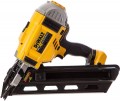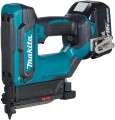Fastener type
—
Nail. Traditional nails are pointed rods with hats. However, hammers are often made for specific types of nails, and ordinary ones cannot be charged in them, this point in each case must be clarified separately. The nail is usually hammered in as a whole, right up to the head; such fasteners are tightly held in the material.
—
Staple. Colloquially, staples are sometimes referred to as "paper clips", although this is not entirely true. Such fasteners are familiar to many from ordinary stationery staplers, however, staples can also be used for more serious tasks — for example, attaching upholstery to wooden furniture. They do not hold as tightly as nails, but the oblong shape of the staple is in some cases a decisive advantage, and reliability is often enough.
—
Pin / hairpin. Fasteners that are driven in the same way as nails, but do not have expanded hats at the top. In addition, they differ somewhat in application: the pin can protrude above the surface of the material, or vice versa, be completely hidden inside, in such a way that then “mask” the fasteners with putty, decorative film, etc. All this requires specific design features, so not every stapler capable of using nails will be compatible with pins / studs.
Fastener sizes
Standard sizes of fasteners for which the tool is designed. This information is necessary for the correct selection of consumables: each standard dimensions corresponds to certain dimensions of parts, and sometimes also design features. There are a great many standards describing standard sizes; they differ not only in the type of fastener, but also in the geography of application and even by specific manufacturers. Detailed data on various standard sizes can be found in special sources; here we will provide general points on some of the most popular options.
First of all, it is worth saying that the standard dimensions describes only two parameters - thickness and width (for nails - size and width of the head). The length can be different: for example, for the popular staple dimensions 53, the length range can be from 4 to 14 mm, and for 140 - from 6 to 14 mm. At the same time, tools for a certain standard dimensions are not necessarily compatible with all length options. So when assessing compatibility with consumables, you should pay attention not only to this point, but also to the restrictions on the minimum and maximum length of fasteners.
This is what the list of the most popular sizes for rectangular brackets looks like:
- 55. One of the smallest sizes used in modern staplers is 6 mm wide and 1.1 mm thick.
- 90. Another relatively small standard dimensions, it has even a slightly smaller width - 5.8 mm - and a thickness in the...range of 1 - 1.27 mm.
— 57. Staples 10.6 mm wide and 1.2 mm thick.
- 59. The “thin” analogue of dimensions 57, with the same width, provides a thickness of only 0.75 mm.
— 140. Quite rigid staples with a width of 10.6 mm and a thickness of 1.24 mm.
- 114. A slightly enhanced variation of dimensions 57, with increased width and thickness - 10.8 mm and 1.4 - 1.6 mm, respectively.
- 53/53F. Quite wide (11.3 mm) staples, available in both 0.75 mm (53) and 1.25 mm (53F) thicknesses.
— 72. In fact, it’s an analogue of the 53 described above: staples 11.3 mm wide and 0.7 mm thick.
- 54/58. Wide staples 12.8 - 12.9 mm, also available in two thicknesses - 0.75 mm in version 58, 1.25 mm in version 54.
Of the semicircular staples used mainly for fastening cables, the most popular options are:
- S. Relatively small staples with a width of 6.2 mm and a thickness of 1.25.
- L. Larger dimensions - 7.7 mm wide with the same 1.25 mm thickness.
In nails for driving tools, the thickness is indicated by the size, and the width by the largest dimensions of the head. The most popular sizes these days are:
— J. Small fastening nails only 1.2 mm thick with a head width of 2 mm.
— N. Diameter 1.65 mm, cap width 2.8 mm.
- DA. The so-called finishing (finishing) nails are quite large in dimensions: size 1.8 mm, head width 3.5 mm. The head has a characteristic D-shape and, as befits finishing nails, when hammered, it is almost completely recessed into the material.
Regarding pins/studs, it is worth noting that such fasteners are actually nails without heads. Therefore, the main dimensions of such parts is thickness (size), for the most common standard sizes it is as follows:
— 40. Thin pins/studs, only 0.64 mm thick.
— 41. Larger fastener, with a size of 1.2 mm.
Detailed information on choosing a standard dimensions for specific tasks can be found in special sources.
Compatible pins
Models of pins and/or studs that the tool is compatible with.
Usually, quite specific options are indicated in this paragraph, so finding compatible consumables is not difficult. The specific dimensions of the fasteners should be specified according to the manufacturer's data — different brands use different markings.
Magazine angle
The angle at which the magazine is set in the tool. Note that in this case, the angle is measured relative to the perpendicular to the body, more precisely, to the direction of the “shooting” of the fastener; in other words, if the angle of inclination is 0 °, this means that the store is strictly perpendicular to the body. This makes quite a practical sense: an inclined magazine makes it easier to work in hard-to-reach places, driving fasteners at an angle and some other specific tasks, and the greater the deviation of the magazine from the perpendicular, the more pronounced these advantages. At the same time, the real need for such a design is not always required, so many staplers (especially entry-level ones) have a perpendicular magazine, and in such cases the angle of inclination (0 °) is not indicated at all.
Also note that fasteners (especially branded ones, for a tool of a certain brand) can be sold in packs designed for a specific store angle; in such packs, the parts themselves are connected with a slope corresponding to this angle.
Magazine capacity
The number of fasteners that fit in the stapler magazine.
Note that manufacturers tend to indicate the maximum number of parts in the characteristics — that is, the capacity for the thinnest fasteners allowed by the design of the tool. Accordingly, fewer larger parts will fit in the store; this must be taken into account when choosing. Nevertheless, this parameter makes it possible to evaluate the instrument and compare models similar in class to each other.
Large capacity, on the one hand, allows you to work longer without interruptions to recharge the stapler. On the other hand, volume magazines are usually very bulky and can weigh a lot on their own, not to mention the weight of the fasteners loaded in them. Also, if parts are charged one at a time, recharging can become quite a long and tedious affair. Therefore, it makes sense to specifically look for a tool
for 100 parts or more(especially when it comes to thick fasteners) only if the ability to work for a long time without reloading is more important than the disadvantages described above.
Min. nail diameter
The smallest thickness of nails (see "Type of fastener") that the stapler can work with.
A nail that is too thin is just as undesirable for a tool as one that is too thick: already in the store, such parts can hang out, and there is no question of correct “shooting” at all. Therefore, this limitation should definitely be taken into account when choosing, especially if you plan to work with nails of small thickness. The most "thin" modern staplers have a minimum limit of about 1 mm, and in professional models it can exceed 2.5 mm and even 3 mm.
Max. nail diameter
The largest thickness of nails (see "Type of fastener") that the stapler can work with.
Thick nails require not only the appropriate size of the magazine and feeder, but also significant effort is required to drive them. Therefore, the larger the maximum allowable nail diameter, the more powerful, heavier and more expensive the tool, usually. Professional pneumatic nailers can be compatible with fasteners of 3.5 mm or more, but for entry-level tools, a thickness of 1.2 — 1.5 mm is often more than enough.
Min. nail length
The shortest length of nails (see Fastener Type) that the stapler can handle.
The shorter the fastener, with the same thickness, the less effort is required to drive it, but a nail that is too short simply cannot stand under impact normally. Therefore, for many instruments, this restriction is directly indicated. It is worth paying attention to it first of all if you plan to work with small short nails.
Max. nail length
The longest length of nails (see Fastener Type) that the stapler can handle.
With the same thickness, a longer nail requires not only the appropriate space in the magazine and feed mechanism, but also a higher impact energy — otherwise it simply will not work to hammer it “on the head”. This means that the maximum fastener length is directly related to the power and, accordingly, the overall level of the tool. Recall that a powerful professional tool has the appropriate dimensions and weight, moreover, it is often made pneumatic (for more details, see "Type"). Therefore, it makes sense to look for models that are compatible with long nails only if this is critical for the planned work.

